AIN KAREM
“During those days, Mary set out and traveled to the hill country in haste to a town of Judah, where she entered the house of Zechariah and greeted Elizabeth. When Elizabeth heard Mary’s greeting, the infant leaped in her womb, and Elizabeth, filled with the Holy Spirit, cried out in a loud voice and said: “Most blessed are you among women, and blessed is the fruit of your womb.” (Luke 1:39-42)
Once the Archangel Gabriel departed after the Annunciation, Luke tells us that Mary set out from Nazareth in haste to the hill country, to a town of Judah, to visit her cousin Elizabeth, who had wondrously conceived a son in her old age and was already in her sixth month of pregnancy (Luke 1:36). The Scriptures do not name the town to which Mary hastens, but, according to tradition, she went to Ain Karem, a very hilly region, which is about 75 miles from Nazareth. Elizabeth and Zechariah lived here and, later, also their son John. What occurred in Ain Karem was the Visitation (Lk 1:39-45), including the Magnificat (vv. 46-56); the birth of John the Baptist (vv. 57-66) including the Benedictus of Zechariah (vv. 67-79), and mention of John living “in the desert until the day of his manifestation to Israel” (v. 80). St. John Ba-Harim (see picture) means “St. John in the Mountains.”

(photo: SMRP: St. John Ba-Harim)
St. John Ba-Harim was the name of Ain Karem in the Middle Ages.

(photo: Catholic Scripture Study)
There are two Catholic churches in Ain Karem: The Church of the Nativity of St. John the Baptist and the Church of the Visitation, the latter located on outskirts of the town. On the route between the two churches, there is a spring of water called the Fountain of the Vineyard, which is the meaning of the town’s name: ein (fountain) of the karem (vineyard).
The Church of St. John the Baptist commemorates the birth of John and the famous hymn of Zechariah. The Franciscans of the Holy Land built the present church in the 17th century with the help of the Spanish monarchy.

(photo: SMRP: Church of St. John)
The high altar is dedicated to St. John.
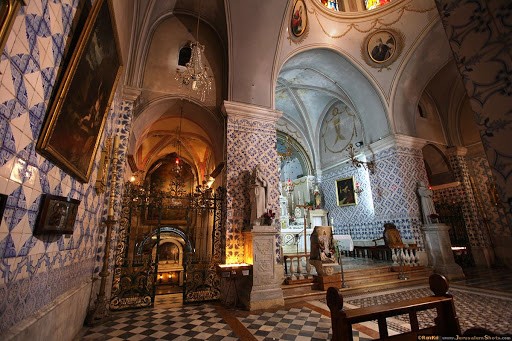
(photo: Jerusalem Shots: interior of the church)
Now let us descend the stairs to the side of the altar to a natural grotto. Here we find what is believed to be part of the home of the Baptist’s parents.
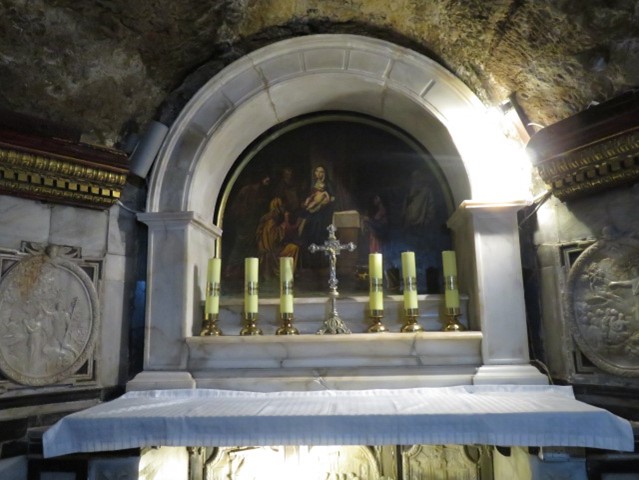
(photo: SMRP: grotto below)
John’s birthplace is commemorated with a little round disk on the floor where we read: “Here the precursor of the Lord was born.”
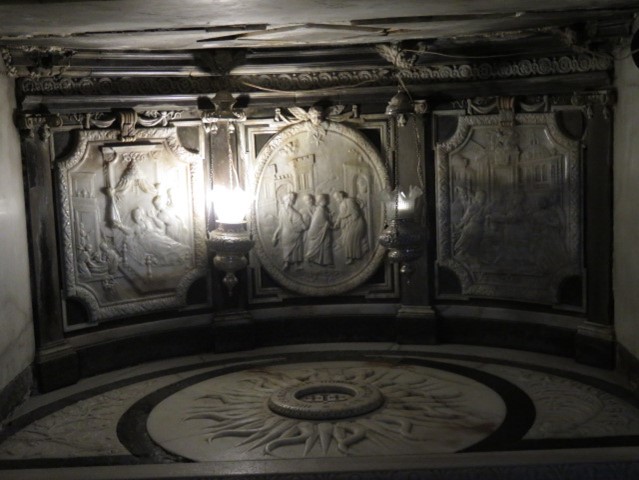
(photo: SMRP: John’s birthplace)

(photo: SMRP: Latin inscription)
Before going on to the Church of the Visitation, I would like to preface our description of this church with this statement: it is more likely that both the birth of John the Baptist and the Visitation occurred at the location of the current Church of St. John the Baptist, that is, if we are convinced of the findings of early Christian history before the 10th century. However, due to a certain monk, Daniel, the events came to be separated, geographically. Why this happened no one knows for sure. Perhaps it was in order to accommodate pilgrims, since the site of the house of John was closed to Christians during the centuries in which it was occupied by Muslims, until the Franciscans recovered it in the second half of the 16th century (Rev. Charles Samson, A Catholic Guide to the Holy Land).
Certainly the Church of the Visitation, located on the slope of the hill south of Ain Karem, is a glorious tribute to Mary with its biblical, historical and doctrinal frescoes, mosaics and ceramic plaques. Here we can contemplate the encounter of Mary with Elizabeth and Mary’s hymn of praise.
The church was completed in 1955 to a design by Antonio Barluzzi and is considered one of the most beautiful of all the Gospel sites in the Holy Land. On the façade is a mosaic depicting the Visitation.
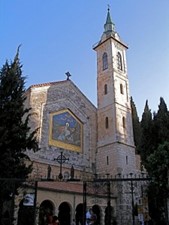
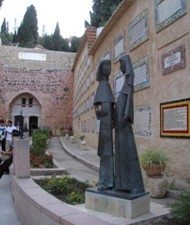
(left photo: seetheholyland.net: façade of church) (right photo: seetheholyland.net: courtyard)
On a wall opposite the church, ceramic plaques reproduce Mary’s Magnificat in 50 languages.

(photo: seetheholyland.net: Magnificat in 50 languages)
In the church’s lower level, a rock memorializes the second century legend that Elizabeth and her baby John escaped there from the massacre of the Holy Innocents (Mt 2:16). We read in the Protoevangelium of James 22.3:
“Elizabeth, having heard that they were searching for John, took him and went up into the hill-country, and kept looking where to conceal him. And there was no place of concealment. And Elizabeth, groaning with a loud voice, said: “O mountain of God, receive mother and child.” And immediately the mountain was cleft, and received her.” (translated by Alexander Walker, 1886)
The rock has the imprint of a baby’s body. Above the rock is a Latin inscription which means: “In this rock it was given for Elizabeth and John to hide away.” The event is depicted in a painting on the wall.

(photo: seetheholyland.net: rock and inscription)
POINTS FOR REFLECTION:
*The mystery of the Visitation is a mystery of joy. John the Baptist leaps joyfully in his mother’s womb; Elizabeth rejoices at the gift of motherhood; she praises the blessings of the Lord; Mary raises her heart to God in the Magnificat, which is a hymn overflowing with Messianic joy. The Magnificat is the song of the Messianic times in which there mingles the joy of the ancient and the new Israel … Mary’s hymn has spread far and wide and has become the prayer of the whole Church in all ages (Pope Saint John Paul II, Homily, May 31, 1979).
-Pope Emeritus Benedict XVI preached in a homily that joy “must be shared. Joy must be communicated. Mary went without delay to communicate her joy to her cousin Elizabeth…This is the real commitment of Advent: to bring joy to others. Joy is the true gift of Christmas…We can transmit this joy simply: with a smile, with a kind gesture, with some small help, with forgiveness. Let us give this joy and the joy will be returned to us. Let us seek in particular to communicate the deepest joy, that of knowing God in Christ. Let us pray that this presence of God’s liberating joy will shine out in our lives” (Homily, December 18, 2005).
-The Magnificat is a prayer that we pray every day. Do I imitate Mary by welcoming Jesus and bringing Him to others? Do I let my life become a Magnificat, a praise of God? Let us ask this grace from the Virgin Mary.
